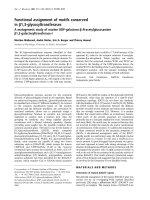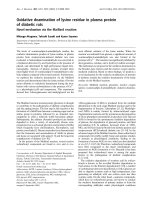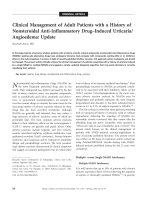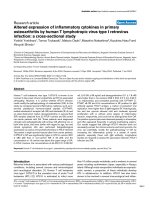Báo cáo y học: " Early finding of chest wall metastasis of hepatocellular carcinoma in a woman by fluorodeoxyglucose-positron emission tomography scan: a case report" doc
Bạn đang xem bản rút gọn của tài liệu. Xem và tải ngay bản đầy đủ của tài liệu tại đây (310.04 KB, 3 trang )
CAS E REP O R T Open Access
Early finding of chest wall metastasis of
hepatocellular carcinoma in a woman by
fluorodeoxyglucose-positron emission
tomography scan: a case report
Lixin Yang
1
, Howard Marx
2
and Yun Yen
1*
Abstract
Introduction: The use of fluorodeoxyglucose-positron emission tomography to evaluate well-differentiated
hepatocellular carcinomas is facing critical problems. It is reported that the activity of fluorodeoxyglucose-
6-phosphatase, which converts fluorodeoxyglucose-6-phosphatase to fluorodeoxyglucose, is high in normal liver
cells. However, the enzyme-converting activity of glucose-6-phosphatase of well-differentiated hepatocellular
carcinomas is similar to normal liver tissue. Thus, using fluorodeoxyglucose in diagnosing primary hepatocellular
carcinomas is difficult. However, using fluorodeoxyglucose to detect extrahepatic metastasis of hepatocellular
carcinomas is still possible.
Case presentation: We describe the case of a 45-year-old Chinese woman who developed a recurrent lesion in
the chest wall from a previous surgically resecte d hepatocellular carcinoma. This recurrent lesion was detected first
on the basis of a positron emission tomography scan, then on the basis of a computed tomography scan and
other clinical tests.
Conclusion: This finding indicates that the positron emission tomography scan is a potentially reliable tool to
screen for systemic me tastatic disease in patients with hepatocellular carcinomas when other cross-sectional
imaging tests such as computed tomography or magnetic reso nance imaging are negative.
Introduction
Hepatocellular carcinoma (HCC) is the fifth most com-
mon c ancer worldwide [1]. It has a high mortality rate,
with most patients succumbing to the disease within
one year [ 1]. The presence of metastatic disease in these
patients markedly reduces survival [2]. Recently, the
occurrence of liver cancer in the United States of Amer-
ica has been increasing because of the increased fre-
quency of hepatitis C [3]. Liver cancer tends to spread
to nearby lymph nodes, bones and lungs. In rare cases,
it spreads to the chest wall with or without identifi ed
primary liver cancer. It is essential to diagnose HCC in
its early stages to ensure patient survival [2,4]. Ultra-
sound, computed tomography (CT), magnetic resonance
imaging (MRI) and positron emission tomography (PET)
are the primary imaging methods for the diagnosis of
liver cancer [5]. The PET scan is an emerging imaging
modality that measures and distinguishes the increased
rates of glucose metabolism and oxygen consumption in
tumor tissue from normal surrounding tissue. The
advantage of PET scans is that they measure metabolic
changes at the cellular level [6]. On the other hand,
cross-sectional imaging modalities such as CT, ultra-
sound, and MRI detect anatomical changes. Thus, PET
scans allow complementary anatomical detection and
measurement of cellular activity in tumors. However,
the average false-negative rate of PET scans is 40% to
50% for the detection of HCC because of active glucose
metabolism in normal hepatic parenchyma. It has been
demonstrated that glycolysis metabolism within HCC is
equivalent to or less than that of normal liver tissue.
Therefore, most primary HCCs are underdetected by
* Correspondence:
1
Department of Medical Oncology, City of Hope National Medical Center,
1500 East Duarte Road, Duarte, CA 91010, USA
Full list of author information is available at the end of the article
Yang et al. Journal of Medical Case Reports 2011, 5:147
/>JOURNAL OF MEDICAL
CASE REPORTS
© 2011 Yang et al; licensee BioMed Central Ltd. This is an Open Access article distributed under the terms of the Creative Commons
Attribution License ( which permits unrestrict ed use, distribution, and reproduction in
any medium, provided the original work is properly cited.
PET scans [7,8]. However, PET scans have shown benefit
in the detection of early metastasis in extrahep atic sites,
especially in the frequent metastatic organs, such as the
colon, lung, brain and lymph nodes [9,10]. In this
case report, we describe a chest wall metastasis of HCC
that was uniquely detected by PET scan but not by
CT scan. This r eport indicates that whole-body PET
is a potentially valuable method to screen for the early
presentation of extrahepatic metastatic disease.
Case presentation
A 45-year-old Asian woman with a known history of hepa-
titis C for 20 years had received no interferon treatment
for her hepatitis C. The patient developed HCC and
underwent successful surgical resection with a negative
surgical margin. Her pathological specimen allowed the
diagnosis of well-differentiated HCC in postsurgical f ol-
low -up, and th e patient underwent CT scans ever y three
months, alternating with ultrasound. All results of these
scans were reported to be unremar kable except for post-
surgical changes. A blood test was also done, including
measurement of a-fetoproteins (AFPs). One year later the
patient’s AFP w as slightly elevated at 25 mg/dL (normal
range, <10 mg/dL). Repeated CT scans and ultrasounds of
the patient’s abdomen revealed no changes from previous
examinations. Upon physical examination, the patient was
noted to have small induration areas over the upper-left
chest wall and under the left clavicle bone with a size of
approximately 1 × 1 cm
2
. The patient denied any trauma
or pain related to the area. Because AFP le vels continued
to increase to 40 mg/dL, a PET scan was ordered. For PET
imaging, the patient was injected with 10.9 mCi of
18
F-fluorodexyglucose (FDG). One hour la ter the patient
voided and underwent PET with or without attenuation
correction. Imaging was performed in multiple acquisi-
tions to include the face, neck, chest, abdomen, pelvis and
proximal thighs. Images were acquired using 2-D imaging
and reconstructed in three planes. 3-D tomographic
reconstruction and analysis were carried out.
The PET scan showed a focus of slightly elevated FDG
uptake in the left infraclavicular region with a standar-
dized uptake value of 2.0 (Figures 1a and 1b). It was
interpreted as showing possible metastatic disease. How-
ever, the CT scan was interpreted as showing no residual
tumor or metastatic disease. Subsequently, the patient
underwent resection of a palpable subcutaneous nodule
not visualized on the CT scan, but correlated with the
above-described PET scan abnormality i n the left infra-
clavicular region. The patient’s pathological examination
confirmed metastatic HCC of the chest wall.
Discussion
HCC is the third highest cause of cancer mortality
worldwide, and the incidence of HCC in the United
States is increasing [4]. The etiology of HCC is believed
to be from hepatitis B and C, but its increased incidence
is due to metabolic disorders such as diabetes. The diag-
nosis of HCC is dependent upon AFP, tissue biopsy and
imaging studies. Although ultrasound, CT and MRI
have be en widely used to detect HCC, PET has
remained out of favor for the diagnosis of HCC because
of the lack of differentia tion between HCC gluco se
metabolism and normal liver tissue. However, on the
basis of a literature search, the PET scan has shown
promise in distinguishing extrahepatic metastatic tumors
from normal surrounding tissue. The reports show that
the sensitivity of PET is about 80%, its specificity is 75%
to 90% and its accuracy is around 80% [9,10]. Thus,
PET may de tect early extrahepatic HCC lesions in clini-
cal follow-up. In the reported studies, the PET scan has
been successfully used in detecting extrahepatic HCC
lesions such as those of the lymph node, lung, bone,
vasculature and adrenal gland. However, some uncom-
mon metastatic sites of HCC, such as sk in or sof t tis-
sues, have not been detec ted by PET or have not been
reported yet. On the other hand, lesions in these tissues
can be missed by using CT or MRI technologies. The
PET scan, by measur ing elevated glucose metabolism in
tumo rs, has shown promise in distinguishing extrahepa-
tic metastatic tumors from normal surrounding tissue
[9,10]. Thus, the use of PET in clinical follow-up may
be beneficial in detecting early metastatic HCC lesions
which are not defined in the liver.
In the patient described in the present report, the chest
wall tumor that developed from HCC was detected by
A
B
Figure 1 (a) Metastatic lesion in chest wall was markedly positive
for uptake with tracer (arrow). (b) The corresponding computed
tomographic image reveals that no lesion can be identified.
Yang et al. Journal of Medical Case Reports 2011, 5:147
/>Page 2 of 3
obtaining a PET scan as the earliest step, in comparison
to a CT scan. This result provided very valuable and
uniq ue information that affected the patient’streatment
plan. The patient underwent immediate local resection of
the metastatic lesion in accordance with t he standard
treatment guideline [11]. Furthermore, the patient was
started on sorafenib treatment as a first-line targeted
therapy immediately after the PET scan identified the
metastatic lesion over the chest wall. Th e response to
sorafenib treatment provides further progression-free sur-
vival. Therefore, the early diagnosis of a metastatic lesion
on the basis of a PET scan ensures a better prognosis for
the patient, initiation of the most accurate therapy and
increased patient survival. Although most HCC metas-
tases occur in the gastrointestinal tract, lung and bone,
HCC does metastasize to many other organs, including
the chest wall [12]. Therefore, it is important to be ab le
to identify these lesions in an imaging study such as a
PET scan, as in our present case, where PET was the
only tool that successfully detected a pathologically pro-
ven chest wall metastasis. Although further investigation
is needed with larger groups of patients to validate the
superiority of PET to detect extrahepatic metastatic dis-
ease in patients with HCC, we believe it is a promising
method, in combination with other studies, to detect rare
sites for metastatic disease. Even though the PET scan is
regarded as an insensitive method for the detection of
primary HCC, one clinical study did demonstrate that
18
F-FDG PET/CT had a relatively high sensitivity in
detecting extrahepatic HCC lesions [13].
Conclusion
It has been reported that the PET scan provides addi-
tional information for the diagn osis of extrahepatic
HCC [ 9,14] and is an important tool for surveillance of
distant metas tasis in patients with unexplained AFP ele-
vation after HCC treatment [15]. Therefore, we suggest
that the use of whole-body
18
F-FDG PET/CT be consid-
ered in the follow-up of patients with HCC for potential
early detection of systemic metastatic extrahepatic
disease.
Consent
Written informed consent was obtained from the patient
for the publication of this case r eport. A copy of t he
written consent is available for the review by the Editor-
Chief of this journal.
Abbreviations
AFP: α-fetoprotein; CT: computed tomography;
18
F-FDG:
18
F-fluorodeoxyglucose; GI tract: gastrointestinal tract; HCC: hepatocellular
carcinoma; MRI: magnetic resonance imaging; PET: positron emission
tomography; SUV: standardized uptake value.
Author details
1
Department of Medical Oncology, City of Hope National Medical Center,
1500 East Duarte Road, Duarte, CA 91010, USA.
2
Department of Radiology,
City of Hope National Medical Center, 1500 East Duarte Road, Duarte, CA
91010, USA.
Authors’ contributions
All authors contributed to the writing and editing the case report. LY carried
out the literature search. YY collected the medical history. HM obtained the
images. All the author s read and approved the final manuscript.
Competing interests
The authors declare that they have no competing interests.
Received: 23 October 2009 Accepted: 13 April 2011
Published: 13 April 2011
References
1. Parkin DM, Bray F, Ferlay J, Pisani P: Estimating the world cancer burden:
Globocan 2000. Int J Cancer 2001, 94:153-156.
2. Tandon P, Garcia-Tsao G: Prognostic indicators in hepatocellular
carcinoma: a systematic review of 72 studies. Liver Int 2009, 29:502-510.
3. El-Serag HB, Davila JA, Petersen NJ, McGlynn KA: The continuing increase
in the incidence of hepatocellular carcinoma in the United States: an
update. Ann Intern Med 2003, 139:817-823.
4. Kemp W, Pianko S, Nguyen S, Bailey MJ, Roberts SK: Survival in
hepatocellular carcinoma: impact of screening and etiology of liver
disease. J Gastroenterol Hepatol 2005, 20:873-881.
5. Ariff B, Lloyd CR, Khan S, Shariff M, Thillainayagam AV, Bansi DS, Khan SA,
Taylor-Robinson SD, Lim AK: Imaging of liver cancer. World J Gastroenterol
2009, 15:1289-1300.
6. Delbeke D, Martin WH, Sandler MP, Chapman WC, Wright JK Jr, Pinson CW:
Evaluation of benign vs malignant hepatic lesions with positron
emission tomography. Arch Surg 1998, 133:510-516.
7. Khan MA, Combs CS, Brunt EM, Lowe VJ, Wolverson MK, Solomon H,
Collins BT, Di Bisceglie AM: Positron emission tomography scanning in
the evaluation of hepatocellular carcinoma. J Hepatol 2000, 32:792-797.
8. Trojan J, Schroeder O, Raedle J, Baum RP, Herrmann G, Jacobi V, Zeuzem S:
Fluorine-18 FDG positron emission tomography for imaging of
hepatocellular carcinoma. Am J Gastroenterol 1999, 94:3314-3319.
9. Ho CL, Chen S, Yeung DW, Cheng TK: Dual-tracer PET/CT imaging in
evaluation of metastatic hepatocellular carcinoma. J Nucl Med 2007,
48:902-909.
10. Iwata Y, Shiomi S, Sasaki N, Jomura H, Nishiguchi S, Seki S, Kawabe J,
Ochi H: Clinical usefulness of positron emission tomography with
fluorine-18-fluorodeoxyglucose in the diagnosis of liver tumors. Ann Nucl
Med 2000, 14:121-126.
11. Schwarz RE, Smith DD: Trends in local therapy for hepatocellular
carcinoma and survival outcomes in the US population. Am J Surg 2008,
195:829-836.
12. Hyun YS, Choi HS, Bae JH, Jun DW, Lee HL, Lee OY, Yoon BC, Lee MH.
13. Lee DH, Kee CS, Kang JH, Park MH: Chest wall metastasis from unknown
primary site of hepatocellular carcinoma. World J Gastroenterol 2006,
12:2139-2142.
14. Park JW, Kim JH, Kim SK, Kang KW, Park KW, Choi JI, Lee WJ, Kim CM.
15. Nam BH: A prospective evaluation of
18
F-FDG and
11
C-acetate PET/CT for
detection of primary and metastatic hepatocellular carcinoma. J Nucl
Med 2008, 49:1912-1921.
16. Sugiyama M, Sakahara H, Torizuka T, Kanno T, Nakamura F, Futatsubashi M,
Nakamura S:
18
F-FDG PET in the detection of extrahepatic metastases
from hepatocellular carcinoma. J Gastroenterol 2004, 39:961-968.
17. Chen YK, Hsieh DS, Liao CS, Bai CH, Su CT, Shen YY, Hsieh JF, Liao AC.
18. Kao CH: Utility of FDG-PET for investigating unexplained serum AFP
elevation in patients with suspected hepatocellular carcinoma
recurrence. Anticancer Res 2005, 25:4719-4725.
doi:10.1186/1752-1947-5-147
Cite this article as: Yang et al.: Early finding of chest wall metastasis of
hepatocellular carcinoma in a woman by fluorodeoxyglucose-positron
emission tomography scan: a case report. Journal of Medical Case Reports
2011 5:147.
Yang et al. Journal of Medical Case Reports 2011, 5:147
/>Page 3 of 3









